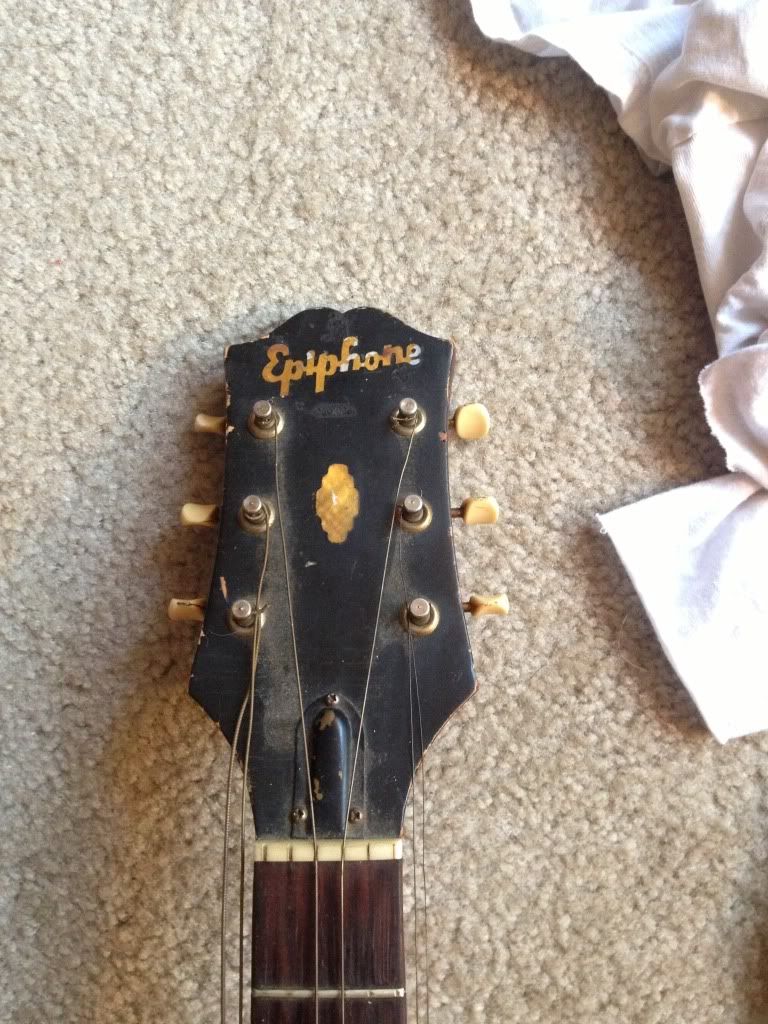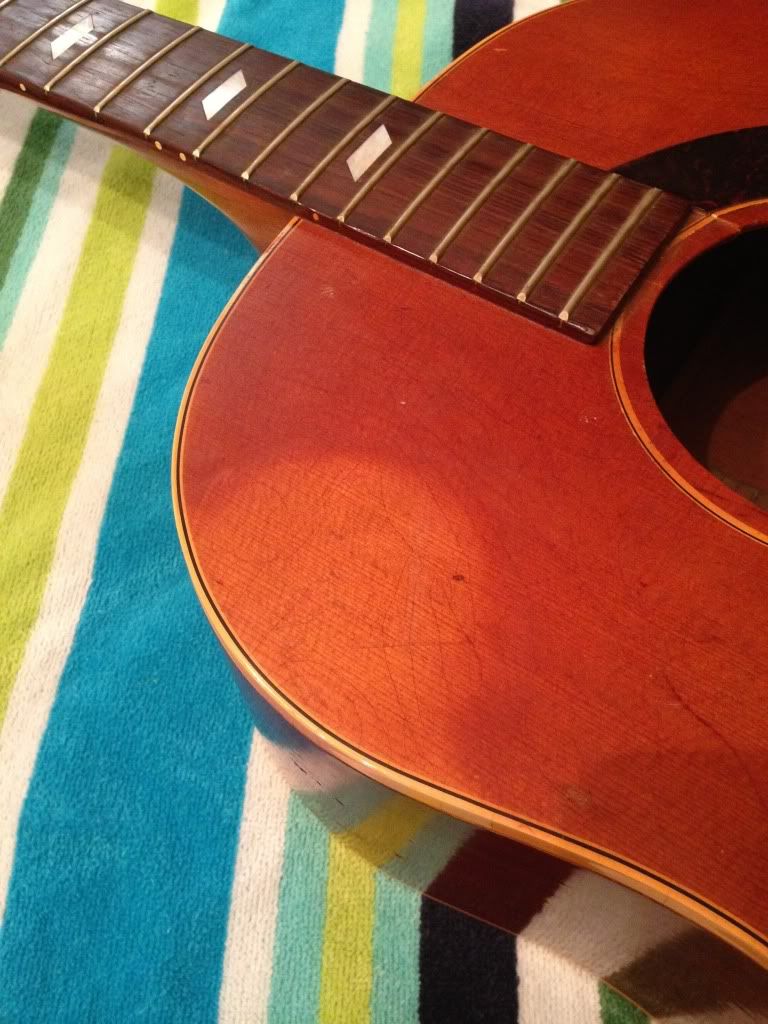By the dawn of the 1950s, the Epiphone company was struggling with problems in both the accounting and labor departments. The company's product line hadn't kept up with the changing trends in guitars such as the new solid body electric (Gibson's Les Paul model?). It had moved the production facilities from New York to Philadelphia in an attempt to avoid a problem with the labor union. By 1957, the company's doom seemed imminent which forced its sale to their biggest competitor, Gibson, for the sum total of only $20,000.
American made Epiphone guitars (both during and before the Gibson buyout) are fantastic instruments. Their relative obscurity and high standard of quality is a recipe for a very inspiring guitar. I recently came across an immediate post-buyout Texan that has me intrigued (
1959 Epiphone Texan with strange features). The description states:
"Gibson FON on the neck block indicating 1952 manufacture, starts with a "Z"; solid, un-kerfed linings (no one has ever seen this on any modern Gibson instrument); the word GUITAR rubber-stamped on the inside of the back, between the neck block and the first back brace; black paint on the heel underneath the clear coat, which has been seen many times on various Gibsons in the 1960's."
1952?
The body is easily dated using Gibson's backwards letter prefix used from 1952-1961. They started with Z in '52 and ended with Q in '61. These letters were stamped on the interior neck block and were proceeded by a batch number (usually 4 digits) then a unique rack number (the Xth number in that rack). This guitar received a Z indicating that it was made in 1952.
Easy, right? Not quite. The description also states that this guitar has solid lining (as opposed to kerfed). Lining is what gives the body's joints (top to rims and rims to back) a solid gluing surface. Usually this lining is kerfed, meaning that it has small cuts vertically to make it bend without needed to be soaked in hot water and bent over a hot pipe.
 |
| Kerfed Lining |
 |
Solid Lining
|
Gibson phased out solid lining in favor of the kerfed style from 1933-1934. I have never seen any flat-top Gibson guitar that used solid lining after 1934. I would venture to say that Gibson
did not build guitars using this kind of lining after 1934. This is my opinion based on my experience so feel free to prove me wrong. Edit: I just acquired one of these guitars. The lining is made of laminated Poplar. The only other place I have seen this is on my 1954 Epiphone FT-210 Deluxe Cutaway. I'm assuming Gibson got leftover strips of lining from Epiphone and used it? Not sure.
(Edit) At least Gibson phased out the use of solid lining made of Mahogany in 1934. After acquiring a buyout period Texan I determined that this "solid lining" wasn't really solid. In fact, it is made of laminated strips of what looks like Poplar. The only other place I have seen this is on my 1954 Epiphone FT-210 Deluxe Cutaway. Perhaps Gibson also acquired strips of unused lining from Epiphone as well as necks?
Gibson "J" body surplus
In the early 50s Gibson was selling some of their jumbo bodies to National. National would manufacture a neck and bolt it on to a Gibson body calling it the National 1155. These are great guitars for the vintage player on a budget but I am told that the necks are a bit difficult to get used to. You'll have to decide that for yourself.

Since National ordered a bunch of J bodies from Gibson, they had more bodies than necks. When a bunch of Epiphone necks showed up at Gibson's doorstep in 1957, the answer was simple. They went downstairs to the parts basement and grabbed a bunch of J sized bodies. That is how I would explain this guitar having a Z (1952) factory order number.
(Edit) .....but I'd be wrong. After acquiring one of these, the tops were definitely made post 1955 judging by the bracing. My next theory would be that Gibson needed finished bodies to sell to National. Since National was bolting on the necks, Gibson needed bodies with uncut neck blocks (instead of cut for a dovetail joint).
When the Epiphone necks showed up in 1958 they were already cut for a dovetail joint. Since the dovetail extension on the neck and the neck block were cut by two different manufacturers they differed to the point that they wouldn't fit right. Gibson would need to use a body with an uncut neck block and cut it to fit the Epiphone neck.
So you have one of these short headstock Texans? Send me some shots of yours. Here is @guitaristo's (Instagram) 1958 Epiphone Texan that has recently been sold. The serial on the blue label was an A-XXX number but he can't remember what was on the neck block. I wonder if it was an earlier FON?
Why do these features even matter?
Although these Texans look like weird J-45s they are certainly not. The main difference in a standard Texan and J-45 is the scale length. Epiphone was using a 25.5" scale length so the necks were manufactured to this spec. Gibson's traditional scale length and that of the J-45 is 24.75". This alone makes for a tone that is probably louder and more piano-like than a J-45. It also doesn't bend strings as well and may wear out your fingers a bit quicker.
This '58 Texan has more than just the scale length to set it apart from a J-45. The body was probably manufactured in '52 which means that it differs from a '57 by the bracing. The pre-'55 J bodies were made with scalloped braces while the post-'55s had straight braces.
(Edit): Wrong again, TVG. While the FON prefix was Y, the tops were definitely made in the late 50s. The bracing is short and straight (unscalloped).
These buyout era features make for an interesting guitar. Mine needs some braces reglued before it is playable again. It was covered in 50 years of sweat and tar until I hit it with some Virtuoso cleaner. Here are some shots of the clean up.
TVG

















